Embark on a spiritual journey at the Chiang Rai White Temple, a masterpiece of contemporary northern Thailand’s art and architecture.
Just beyond the bustling streets and the vibrant culture of Chiang Rai, lies a realm that veers from the traditional path of Thai temples. What if the purest form of spiritual expression wasn’t in shades of gold but in radiant white? The Chiang Rai White Temple, also known as Wat Rong Khun, is more than a mere attraction; it is a compelling narrative of belief, artistry, and universal truths, encapsulated within an architectonic marvel. Crafted with an unwavering dedication to perfection, the temple shines not only through its beautiful facade but through the profound messages woven into its design. As one of the most unique must-visit destinations in northern Thailand, Wat Rong Khun marks a significant dot on the map for Chiang Rai tourism and beckons travelers from across the globe to explore its majesty.
With its glistening white walls and scattered jewels reflecting the wisdom of Buddha, this temple in Chiang Rai extends an invitation to enter a world where artistic brilliance converges with spiritual musings. It’s not only a place to admire, but an experience to imbibe. Let us take you through an odyssey that promises to leave an indelible mark on your soul and presents a conception of beauty that challenges the conventional.
Key Takeaways
- Discover how the Chiang Rai White Temple diverts from traditional Thai temple aesthetics to embody a unique representation of spirituality.
- Uncover the symbolism behind the temple’s white color and glittering mosaics, reflecting purity and enlightenment in Buddhist teachings.
- Learn about the vision of artist Chalermchai Kositpipat and how his masterpiece contributes to north Thailand tourism.
- Embrace the thematic depth of Wat Rong Khun, which seamlessly blends Thai temples traditions with modern artistry.
- Experience the profound journey across the temple’s Bridge of ‘Cycle of Rebirth’, replete with allegorical representations.
- Explore one of the most beautiful temples in Chiang Rai, which is a cornerstone of both the cultural and religious landscape of the region.
An Artistic Masterpiece: The Origin and Creator of Wat Rong Khun
The genesis of Wat Rong Khun, one of the most distinctively unique contemporary temples in Thailand, can be traced back to the boundless creativity and cultural devotion of artist Chalermchai Kositpipat. Known far beyond the borders of Chiang Rai, his home region, Kositpipat’s brainchild defies conventional religious architecture. Embarking on a venture to redefine the horizon of religious landmarks in Thailand, this temple reflects a synthesis of visionary artistry and spiritual enigma.
The Vision of Chalermchai Kositpipat
Chalermchai Kositpipat is no ordinary artist; a son of Chiang Rai and a creative force, he envisaged Wat Rong Khun as a monument that would encapsulate the essence of Buddhist teachings through striking visual narratives. His education at the esteemed Poh Chang Art School in Bangkok armed him with the expertise to reimagine a temple that encompasses not only spiritual significance but also serves as a beacon of art in Chiang Rai.
From Dilapidated Temple to Contemporary Marvel
The site of Wat Rong Khun was once an unpretentious structure on the verge of ruins. In a dramatic turnaround, Kositpipat embarked on a daring project in 1997, transforming the site into an exemplary representation of unique architecture on Thailand’s landscape of sacred structures. This remarkable transformation has left an indelible mark on the township of Chiang Rai and has further elevated the region’s cultural stature among international audiences.
Investment of Passion: A Personal Funded Endeavor
True artistic dedication often demands personal sacrifice, and Chalermchai Kositpipat’s devotion is palpable through his investment of over 30 million baht from his own pocket. His commitment to erecting Wat Rong Khun from a mere vision to a formidable architectural marvel underscores a lifetime’s pursuit of artistic and spiritual fulfillment. This unparalleled contribution underscores the ethos of Wat Rong Khun, not just as a place of worship but as a lifelong canvas of expression for the artist.
The Symbolism Behind the White Temple’s Radiant Aesthetics
Wat Rong Khun’s resplendent design is not only a feast for the eyes but also a profound narrative of Thai Mythology and Buddhist teachings. Every element of its structure is imbued with meaning, contributing to an atmosphere that supports meditation in Northern Thailand. The overwhelming white hue of the temple is a deliberate choice, signifying the pursuit of purity in Buddhism. In contrast, the reflective glass mosaics embedded within the plaster represent the quest for enlightenment, drawing in the light and casting it back out, just as one aims to embody and emanate wisdom.
The path leading to Wat Rong Khun is lined with sculpted hands reaching out, which are vivid representations of human suffering and temptation in the physical world. Further into the complex, the presence of mythical creatures like kinnaras and a Rahu statue embodying Thai mythology serve as guardians of the temple. Through these creative expressions, visitors are reminded of the eternal fight between good and evil, and the importance of moral vigilance according to Buddhist teachings.
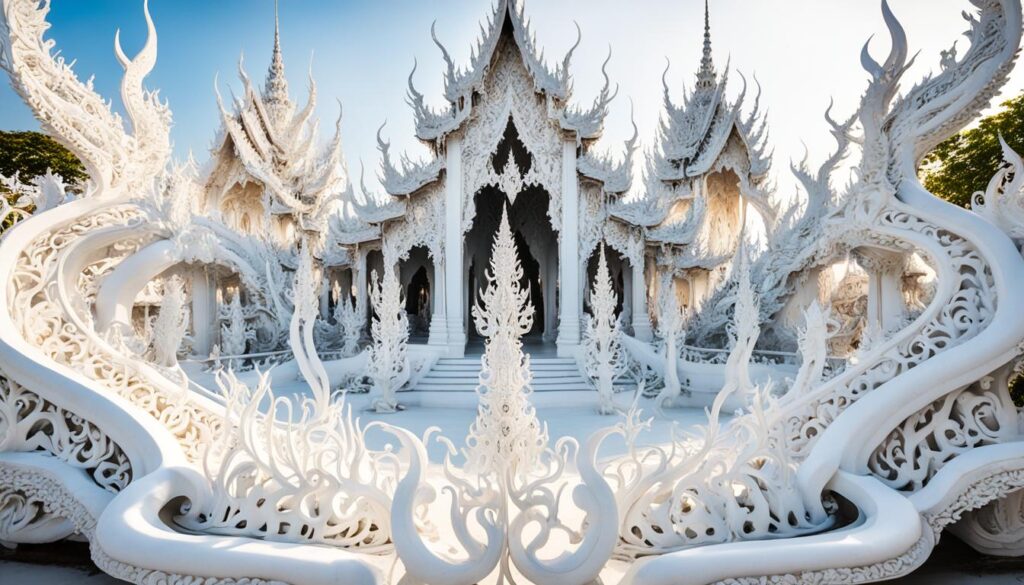
In continuation of its radiant aesthetics and deep symbolism, the table below outlines the symbolic elements and their spiritual meanings, showcasing how they manifest in the architecture. Each feature of Wat Rong Khun not only adds to the temple’s breathtaking beauty but also stands as a testament to the intrinsic relationship between art, spirituality, and ethical principles in the region.
| Symbolic Element | Meaning in Buddhist Teachings | Representation in Thai Mythology |
|---|---|---|
| White Color | Purity and the divine state of Buddha | Heavenly and sacred character in Thai lore |
| Mirrored Glass | Enlightenment reflecting the light of wisdom | Sacred crystals often depicted in myths |
| Sculpted Hands | Human desires and earthly temptation | Demons and negative forces that challenge virtue |
| Kinnaras and Rahu | Guardianship and the cyclical nature of life | Protectors of sacred places and cosmic order |
The architecture of the temple is a physical representation of the journey to spiritual awakening, with each piece contributing to the harmonious blend of symbolism in architecture. For those drawn to both the beauty and the spiritual gravity of such places, Wat Rong Khun offers a transcendent space for meditation in Northern Thailand, allowing for a deeper connection with the teachings of Buddhism amidst the splendor of its radiant aesthetics.
The White Temple Experience: A Journey Through Surreal Artistry
Embarking on the White Temple experience is akin to stepping into an otherworldly narrative where artistry and spirituality converge. Visitors are transported on a journey of spirituality, exploring a landscape that blends devout symbolism with Chiang Rai’s iconic surreal artistry.
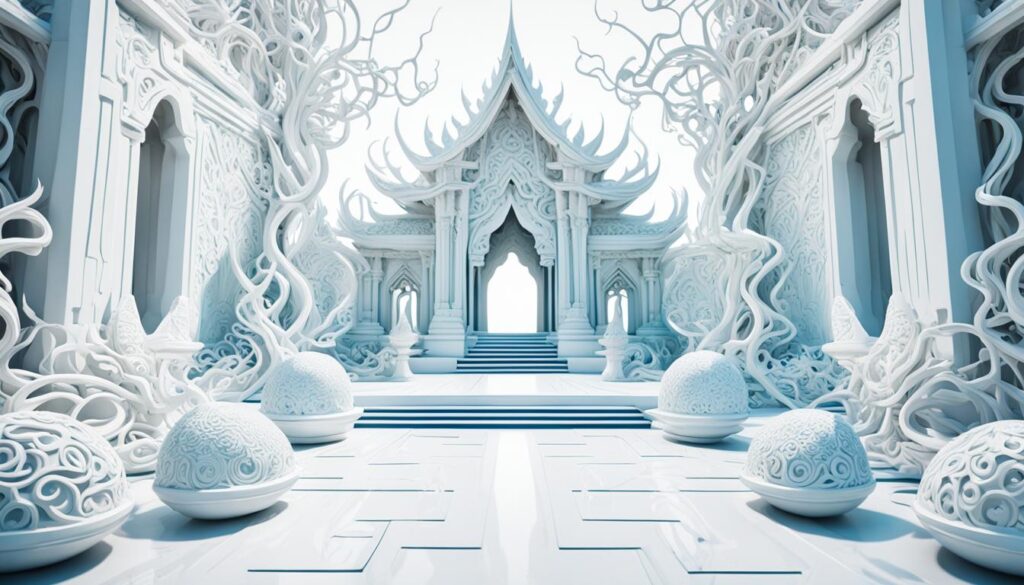
Crossing the Bridge of ‘Cycle of Rebirth’
Within the stunning precincts of the White Temple, the path to enlightenment begins at the ‘Cycle of Rebirth’. Here, visitors encounter a bridge over a sea of outstretched hands symbolizing enduring desires and the human experience of overcoming suffering and reaching toward redemption.
Encountering the Garden of Desires
The Garden of Desires reflects the universe’s temptations, uniquely depicted through detailed sculptures and immersive elements that invite introspection on the complexities of human wants versus spiritual needs.
Insights into the “Gate of Heaven” and the Ubosot
At journey’s end, the Gate of Heaven awaits, a threshold separating the earthly plane from the sacred. Beyond this gate, the Ubosot offers a serene space, encouraging reflection on one’s life and the purity that comes with spiritual awakening.
Chiang Rai White Temple
Immersing oneself in the rich tapestry of Thai culture becomes an unforgettable experience at the Chiang Rai White Temple. This masterpiece is not only one of the most famous temples in Thailand but it has also secured its place among the major Chiang Rai landmarks. Its silhouette is adorned with elements of the traditional Lanna style architecture, distilled through the creative contemporary vision of Chiang Rai-born artist Chalermchai Kositpipat. The temple’s aesthetic further benefits from the profound Sukhothai influence, another hallmark of northern Thailand’s art, which contributes to its serene grandeur.
The ongoing development of Wat Rong Khun reflects an evolving canvas that reverently captures the mystique and spirituality of the region. As one traverses the temple grounds, there’s an undeniable sense that you’re in the midst of a living gallery, where every corner is a deliberate nod to the rich tapestry of myths and legends that characterize the heritage of northern Thailand’s art. A visit to this temple is a pilgrimage to the heart of creativity, making it a must-visit destination for those looking to understand and appreciate the profound depths of Thai culture.
Whether you’re a devout follower of Buddhism, an art enthusiast, or a traveler in search of beauty, the Chiang Rai White Temple stands as a beacon of inspiration. It is a vibrant testament to the creativity that flourishes when a deep reverence for tradition meets a bold, modern spirit. The temple’s unique blend of historical influences with innovative design ensures that it will continue to be a cherished site for generations to come.
Wat Rong Khun’s Interior: A Contrast of Purity and Worldly Illusions
The journey through the ethereal grounds of Wat Rong Khun advances towards a transformative experience as one steps into the sanctuary’s core. Inside the ubosot, visitors are enveloped in a world that defies the tranquil external whiteness and calm. The interior unleashes a striking visual narrative, forcing an encounter with modernity’s stark truths, and showcases the complexity of contemporary society through compelling artistic expressions.
The Striking Visual Narratives Within
Dramatic and unexpected, the art inside the Wat Rong Khun interior departs from traditional religious murals. Instead, it serves as a canvas to a bold exposition: vibrant, sometimes chaotic frescoes that capture the essence of worldly illusions, blending spiritual themes with surreal depictions of modern obsessions. Together, these elements spin a story, not just of morality, but also of stark contrasts. They invite reflection on the purities of faith against the background of real-world challenges and distractions.
Depictions of Contemporary Society and Its Demons
The vivid murals and sculptures transcend mere aesthetic value, emerging as a commentary on the vices that grip contemporary society. The space within juxtaposes the serenity of Buddhist teachings against the tempest of the age, presenting icons of Western pop culture right next to traditional religious art. This contrast of purity with poignant illustrations of temptation and choice showcases the ever-relevant struggle between spiritual awakening and materialistic lure, encouraging introspection on the part of every observer.
FAQ
What is the Chiang Rai White Temple?
The Chiang Rai White Temple, also known as Wat Rong Khun, is a unique and contemporary Buddhist temple in Northern Thailand. It is famed for its striking white exterior and surreal artistry that combines traditional Thai architecture with bold and thought-provoking modern designs.
Who created Wat Rong Khun and what was the vision behind it?
Wat Rong Khun was created by Thai artist Chalermchai Kositpipat, who envisioned the temple as a work of art that would embody Buddhist teachings and integrate them with provocative contemporary themes. He intended it to serve not just as a religious site but as a reflection of human struggle, temptation, and the pathway to enlightenment.
Why is the temple painted white and what does this symbolize?
The temple is painted white to symbolize the purity of the Buddha. The use of white color throughout Wat Rong Khun is intentional and is meant to convey a sense of holiness and tranquility, while the pieces of mirrored glass embedded in its structure represent the Buddha’s wisdom that shines brightly throughout the universe.
Can you describe the experience of crossing the bridge at the White Temple?
Crossing the bridge at the White Temple, known as the “Cycle of Rebirth,” is an immersive experience designed to represent the crossing from the cycle of death and rebirth into a state free from suffering. The bridge takes visitors over a pit of outreached hands that symbolize desire and temptation, leading to the ‘Gate of Heaven’ guarded by two fearsome creatures representing death and Rahu, who decides the fate of the dead.
What can I expect to see inside the temple’s ubosot?
Inside the ubosot, or the main chapel, visitors are confronted with a stark contrast to the exterior’s purity. The walls are adorned with detailed murals that blend Buddhist imagery with contemporary elements, including depictions of modern-day temptations and icons of popular culture. These serve as a reminder of the distractions and vices that lead humans away from the path of righteousness.
How does Wat Rong Khun relate to Thai culture?
Wat Rong Khun is deeply intertwined with Thai culture, drawing inspiration from ancient Lanna and Sukhothai art and architecture. While it incorporates these traditional elements, the temple also presents a unique twist with its modern and unconventional art, creating a cultural bridge that connects Thailand’s historic past with present-day influences.
Is the Chiang Rai White Temple still being constructed?
Yes, the Chiang Rai White Temple is an ongoing project with artist Chalermchai Kositpipat continuing to add to the complex. He has plans for additional structures on the site, ensuring the temple remains a dynamic and evolving work of art.
Are non-Buddhists welcome to visit Wat Rong Khun?
Yes, visitors of all religious backgrounds are welcome to visit Wat Rong Khun. The temple serves as both a place of worship and an art exhibit, inviting people from around the world to admire its beauty and contemplate its symbolic representations of Buddhist teachings and human experience.
What is the best time to visit the White Temple in Chiang Rai?
The temple is open to visitors all year round, but the best time to visit is during the cooler months from November to February, when the weather is more comfortable for exploring. Early morning visits are recommended to avoid the midday heat and capture the temple’s radiant aesthetics in softer light.
Are there any dress code requirements for visiting Wat Rong Khun?
Yes, as a place of religious significance, visitors to Wat Rong Khun are expected to dress modestly. Shoulders and knees should be covered, and visitors are advised to avoid wearing tight, see-through, or revealing clothing.


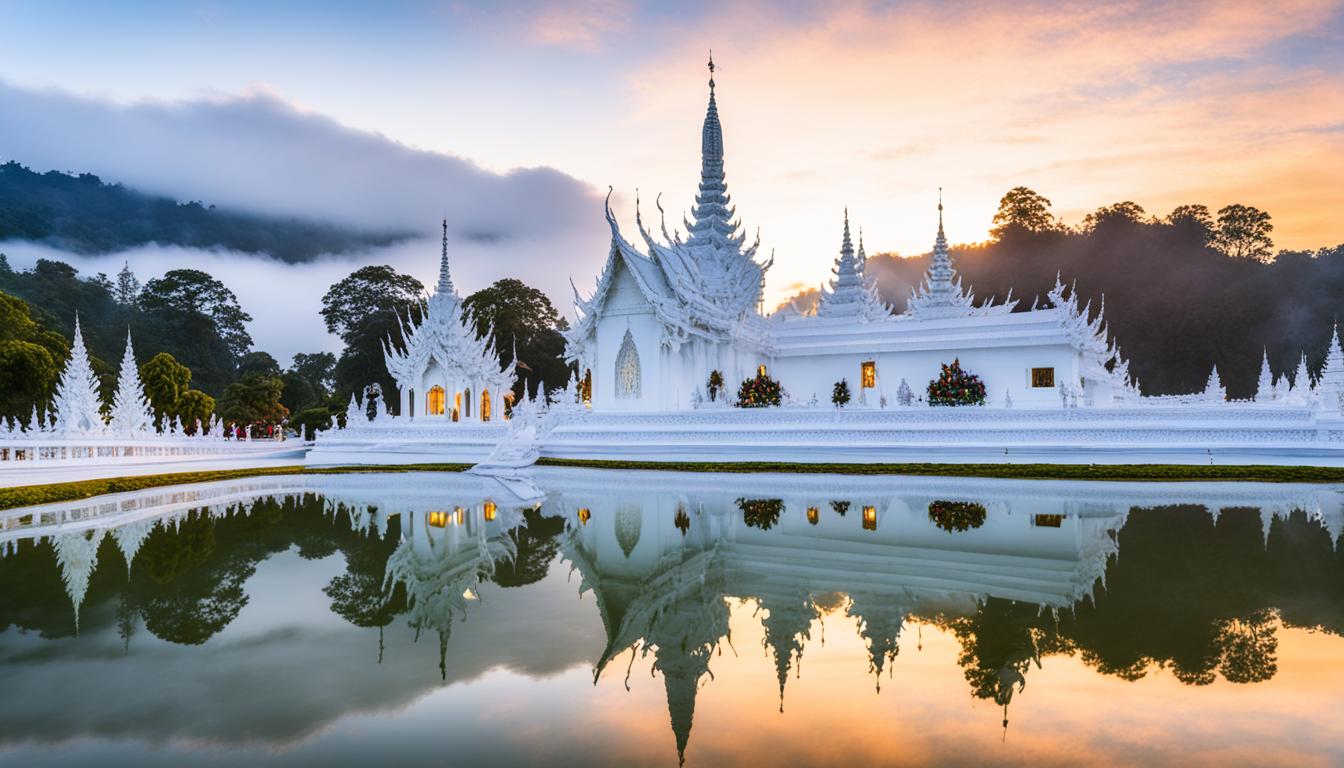
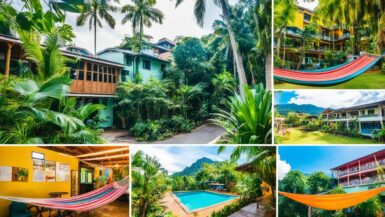
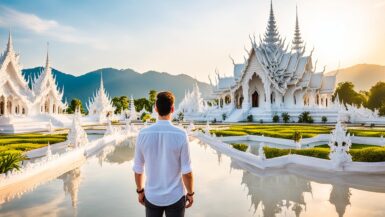
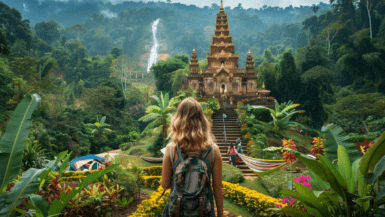
Leave a reply